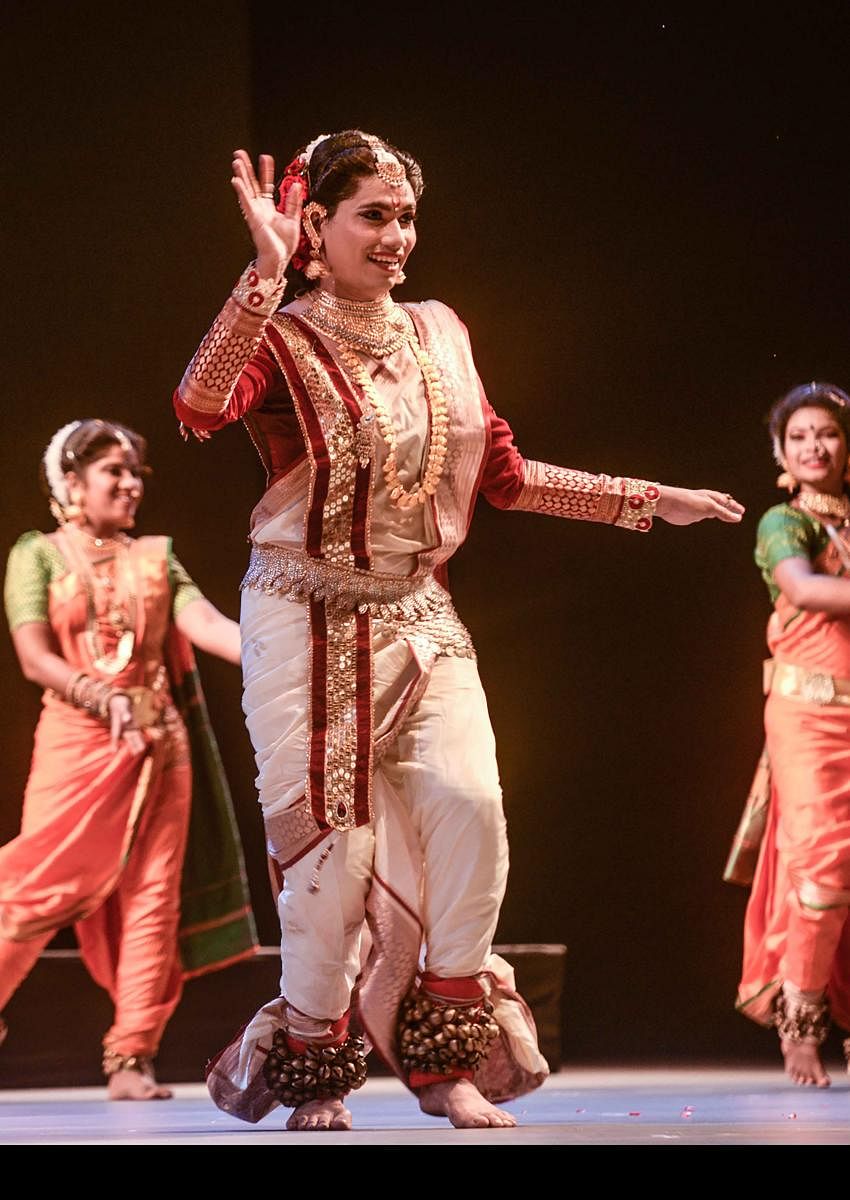
They are graceful.
The swaying of the hips, the arching of eyebrows, the beguiling look, and the wooing of the audience are incomparable. Even the entire look — the nine yards, highly-colourful, rich-looking Paithani silk sari worn in a typical Maharashtrian way of nauvari or the kashta style, with jewellery, large earrings, and bangles reaching up to mid-arm, and hair decorated with mogra gajara are alluring.
And topping this is an unmissable nath. The large pearl and colourful stone-encrusted nose ring completes the attire.
They have a different grace when they walk sensually on the stage with the sound of the innumerable ghungroos tied to their ankle.
That typical come-hither look, the naughty captivating smile and the twinkle in their eyes are so inviting that every heart in the audience may skip a beat either with desire (male hearts) or jealousy (female hearts).
They are the cross-dressing lavani dancers from Maharashtra.
“In Maharashtra, no entertainment is complete without a lavani performance. As they say, ’Lavani shivay tadaka nahin!’ (There is no zing or spice without a lavani dance!),” laughingly admits 27-year-old Ashimik Kamthe, a cross-dressing lavani performer for more than a decade.
Another performer, 38-year-old Anand Satam, who has been performing lavani for nearly two decades now, says, “When I’m dancing, I’m just a performer. Even the audience enjoys a good lavani dance. They aren’t bothered about my gender.”
Conservative roots
Looking a couple of centuries back, the seductive lavani dance was always performed by cross-dressed men as women in those days weren’t allowed to perform in front of a large audience. Lavani is a centuries-old dynamic folk dance of Maharashtra, and some part of south Madhya Pradesh. It has the song, dance and rhythm. The rhythm played on a typical dholki is the most important accompanying instrument of this dancing style.
The lyrics of the song in Marathi can be provocative, sensuous, religious, political, or can express many other sentiments to tease and entertain the audience. During the time of Peshwai in the 18th and 19th centuries in Maharashtra, lavani was used as a source of entertainment to soothe the injured soldiers during wars. It had complete support from the royals, and poets like Honaji Bala, Prabhakar, Ram Joshi and others helped popularise it with their beautiful lyrics. The trend of cross-dressing started then.
From the late-19th to early-20th century, when women started performing in front of a select audience, cross-dressed performers started going into oblivion. By the mid-20th century, the tribe had almost vanished. If at all in any event, cross-dressed performers did dance, the item was used more as comic relief. The respect and the recognition to full-fledged cross-dressed lavani performers, especially in cities and metros, came back probably in 2000 with the Marathi play Bin Baykancha Tamasha. The play was co-founded by two other male dancers, Anil Vasudevan and Anil Hankare.
In fact, Bin Bayakancha Tamasha (A Tamasha sans women) was the first full-fledged play based on lavani without a single woman performer in the troupe. Tamasha is the main folk dance form famous in Maharashtra, and lavani is a part of it.
In small towns and rural areas, men have been performing lavani without any setback. In fact, it has been an accepted practice. So, even when the work had dried up in urban spaces, these men never stopped performing in villages to standing ovation and a lot of praise.
Here comes the praise
Ashimik, who had just returned after his performance at Satara, recalled that after his performance, many elders came backstage to bless “and maajhi drisht sudha kadali (removal of any evil influence), and as a form of blessing, gave me money! This time, I collected more than Rs 2,000 as blessing money.”
In between his performance, Anand said, “The moment we start putting on our makeup, sari, jewellery, we cease to think like men. We become women in our thoughts, behaviour, and this comes out on the stage with the result till the end when the announcements are made, many in the audience believe that they are watching a woman perform. The unbelievable expression after the announcement is our reward. And once we are out of our costume and makeup, we come back to our normal selves.”
But though Ashimik had support from hir family to pursue his art, Anand faced hurdles. Cross-dressing wasn’t appreciated at all. They didn’t object to him learning dance and conducting dance classes, but there was an objection to him dressing as a woman. But today, after watching him perform on reality TV shows, filmy events, plays and become famous, the same people appreciate him.
“Anand isn’t the only one who faced opposition from family and society,” explains Bhushan Korgaonkar, author of Natale Tumchyasaathi — Behind the Adorned Veil Based on the Lives of Lavani Dancers.
“At present, there are more than 100 cross-dressing lavani dancers, and most of them faced problem sometime or the other from family and society, and many a time from some members of the audience.”
Recently, Mumbai-based documentary filmmaker Savitri Medhatul, along with Bhushan, presented Sangeet Bari, a lavani-based programme in which they engaged both Anand and Ashimik to perform a duet lavani as part of the Queer Azadi Mumbai Pride month celebration.
Both Anand and Ashimik feel that to keep alive the purity of this dance form, Bollywood films, TV reality shows and other entertainment shows should not make them appear vulgar by including cheap erotic steps.
“The aesthetics of dance form should be maintained to continue the purity of lavani for many more years! They should follow the way performances at government-sponsored programmes are conducted, or the majority of the Marathi films do.”